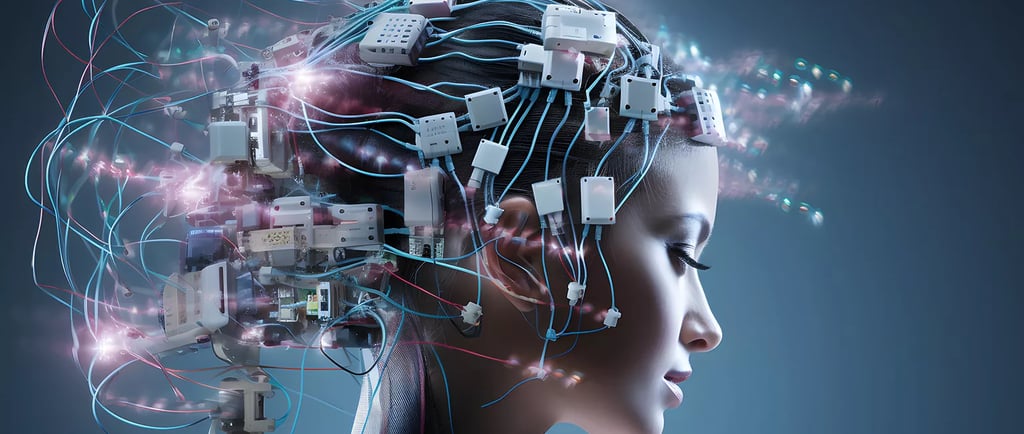items chosen one by one so you have the best option and save money on amazon (Links in articles)
Neural Interfaces: How Brain-Computer Tech Is Revolutionizing Human Interaction in 2025
What if you could type with your mind, control devices with a thought, or even communicate emotion without speaking a word? In 2025, neural interfaces — also called brain-computer interfaces (BCIs) — are no longer experimental tech locked in research labs. They’re becoming commercially available tools, reshaping how humans interact with machines, information, and even each other. From healthcare to gaming, BCIs are transforming the boundaries between biology and technology. Let’s dive into how this revolutionary tech is evolving, where it’s being applied, and what’s already available for early adopters.
5/15/20253 min leer


🧠 What Are Neural Interfaces?
Neural interfaces are systems that enable direct communication between the brain and external devices. They typically use electrodes (non-invasive or implantable) to detect brain signals and translate them into digital commands.
Types of neural interfaces:
Non-invasive: EEG headbands, helmets, or earbuds that sit outside the skull
Minimally invasive: Devices that enter shallow layers of the brain or skull
Implantable: Advanced interfaces like Neuralink, which connect directly to neurons
In 2025, non-invasive options are already available to consumers — and their capabilities are growing fast thanks to machine learning, miniaturized sensors, and real-time signal processing.
⚙️ How Do Brain-Computer Interfaces Work?
BCIs function by detecting electrical activity in the brain (e.g., via EEG) and mapping those signals to specific intentions or patterns, such as:
Moving a cursor
Selecting letters
Controlling a prosthetic limb
Operating a drone or smart home device
Detecting emotional or cognitive states
AI plays a key role, helping the system learn your unique brain patterns over time — increasing speed, precision, and functionality.
🌍 Real-World Applications of Neural Interfaces in 2025
The impact of BCIs spans multiple industries. Here's where it's already making waves:
🩺 Healthcare & Accessibility
Restoring movement: Paralyzed individuals can control robotic arms or wheelchairs with thought
Speech restoration: ALS and stroke patients use BCIs to “speak” via brain signals
Epilepsy monitoring: Early detection of seizures using neural wave tracking
Mental health support: Devices detecting stress, depression, or anxiety before symptoms escalate
🎮 Gaming & Entertainment
Mind-controlled gameplay: Gamers move characters or trigger abilities through focus and imagination
Immersive VR: Emotional feedback systems enhance in-game environments
Neuroadaptive difficulty: Games that adapt to your cognitive load in real time
🧑💼 Work & Productivity
Hands-free computer control: Ideal for engineers, designers, and accessibility users
Focus tracking: Productivity tools that detect distraction or fatigue
Neural typing: Compose emails or code just by thinking
🚀 Advanced Research & Defense
Pilot support systems: Fighter pilots use BCIs for high-speed response scenarios
Brain-to-brain communication: Still experimental, but early versions exist for team communication without voice
🔬 Notable Devices Available in 2025
While invasive devices like Neuralink are in limited clinical trials, several non-invasive neural interfaces are already on the market:
DeviceDescriptionNextMind Dev Kit 2Visual cortex interface, enables thought-controlled UI navigationNeurable Enten EarbudsEEG-powered earbuds that monitor focus and control music or productivity appsCognixion ONEBrain-to-speech interface for nonverbal users, uses AR + EEGMuse S (Gen 3)Brain-sensing headband for meditation, sleep, and cognitive feedbackEmotiv Insight 25-channel EEG headset for developers and neuro-tech enthusiasts
👉 Check the latest neural interface devices on Amazon
👉 Visit the Brain-Tech Wearables Store here
🧠 Is It Safe to Use Brain Interfaces?
Non-invasive devices are generally safe and FDA-compliant, especially those designed for wellness or research.
Key safety considerations:
No electromagnetic feedback into the brain
Data is anonymized and encrypted
Limited wear-time to avoid fatigue or discomfort
Most devices are used under 2 hours/day for optimal signal clarity
For implanted BCIs, safety is monitored in clinical environments with strict medical oversight.
🔒 What About Privacy and Ethics?
BCIs introduce new ethical and legal concerns:
Who owns your brain data?
Can companies predict or influence your thoughts?
What happens if a hacker accesses your mental patterns?
In 2025, many developers are adopting:
On-device data processing (no cloud required)
Opt-in signal collection
Clear ethical guidelines modeled after biomedical standards
Still, experts urge consumers to stay informed and choose trusted manufacturers with transparent policies.
🔮 The Future of Brain-Computer Interfaces
Here’s what we can expect by 2030:
Wireless, implant-free interfaces that use advanced optical sensors
Brain-to-brain messaging for silent communication
Full neural keyboards for ultra-fast typing
Emotion-to-AI translation for improved mental health care
Cognitive prosthetics that enhance memory, focus, and creativity
We're entering the age of cognitive augmentation, where your thoughts become tools — and the only interface you need is your mind.
✅ Final Thoughts: Your Brain Is the Next Frontier
In 2025, neural interfaces are changing what it means to “use” technology. They break the barrier between mind and machine, unlocking a future where thought becomes action instantly.
Whether you're an innovator, gamer, accessibility advocate, or wellness seeker, brain-tech is no longer out of reach — it’s here, and it’s reshaping our daily lives.